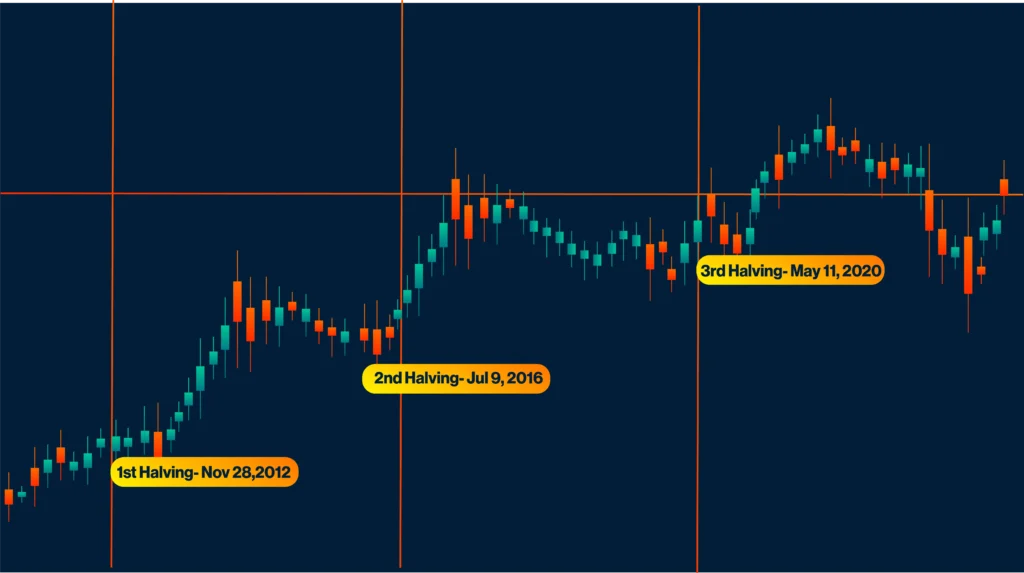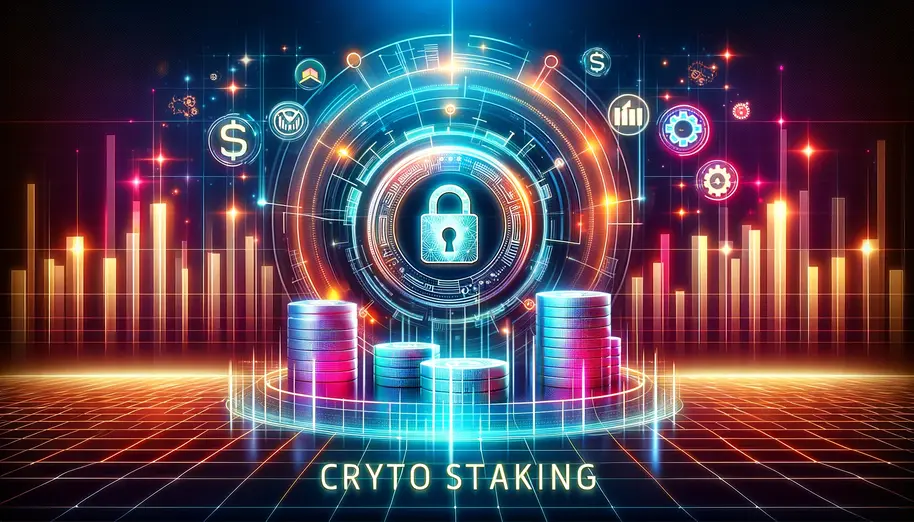Bitcoin Halving Dates 2024: When Is the Next BTC Halving?

Table of Contents
As we know, the maximum number of bitcoins is set at 21 million in order to reflect the finite amount of precious metals in real life. Every four years, the reward for their mining is cut in half, thanks to the built-in mechanism known as Bitcoin halving, making each of the Bitcoin halving dates a huge event.
What is Bitcoin Halving?
Bitcoin halving is a built-in event in the Bitcoin protocol that halves the reward for the mining of new blocks. Halving happens approximately every four years or after every 210,000 new blocks of the total supply of 21 million have been mined.
This is the reason why Bitcoin halving always causes such a stir in the crypto community and on the cryptocurrency exchanges. With this mechanism, the rate at which new bitcoins are created is reduced, ensuring their gradual distribution. This also means that the final Bitcoin won’t be mined until the year 2140. Check out our video on crypto mining for more information:
Another reason why Bitcoin halving exists is to prevent inflation through the controlled supply model. This artificial scarcity mimics the real-life extraction of precious metals, such as gold, which requires more effort over time.
With that in mind, let’s examine when the next halving will occur.
| 💡 Did You Know: | The fixed supply of Bitcoins mimics the real-life limited supply of gold in existence. |
When Is the Next Bitcoin Halving?
Most current predictions put the next Bitcoin halving date around April 19, 2024.
There reason why It’s been challenging to provide the exact Bitcoin halving dates is because the time it takes to mine new blocks is variable. In theory, Bitcoin shoots for a 10-minute average block time, but in reality, there are fluctuations in mining activity and efficiency.
Although the network makes adjustments to mining difficult in order to keep up with the average, rapid changes in the network’s computing power can still lead to variations. All of this prevents the prediction of the exact date until we are close to the actual event.
Bitcoin Halving Dates: History and Impact on the Market
Throughout history, Bitcoin has gone through several halving events, all of which have had a significant impact on the market. Let’s take a look at each one individually.
The First Halving (2012)
The first halving took place on November 28, 2012. Before the event, the block reward was set at 50 BTC. After the halving, the block reward was halved to 25 BTC. This was the first big test for Bitcoin, as it demonstrated the effect of halving on the market, as well as mining.
Following the Bitcoin halving date, the price skyrocketed from $12 to as much as $1,000 by the end of 2012. Because of the now-reduced supply of coins, demand increased, leading to a dramatic price surge.
The Second Halving (2016)
The second halving occurred on July 9, 2016, further reducing the block reward from 25 BTC to 12.5 BTC. The price spiked significantly in the following months, reaching around $2,500. This was attributed to the acceptance of Bitcoin as a valuable asset and the fueled interest in the cryptocurrency market.
So far, both Bitcoin halving dates have led to a spike in price.
The Third Halving (2020)
The third halving happened on May 11, 2020. After May 2020, the block reward dropped to 6.25 BTC. This time around, the price reaction was somewhat muted. However, in the next few months following the halving, the market saw a tremendous bull run. By early 2021, the price surged past $60,000, surpassing any Bitcoin halving price prediction.
This was due to a powerful combo of institutional investments in Bitcoin and its acceptance as a means of payment.
The Bitcoin Halving 2024 Prediction
Based on the historical trends and the current Bitcoin price, the estimated numbers around the 2024 halving, and by the end of the year could look like this:
-
- One month before the halving: The price is estimated to be around $73,431, which is in line with the anticipated increase of about 19.4% leading up to the halving.
- One month after the halving: The price is estimated to be around $75,465, which includes the average change of about 2.77% after the halving.
- By the end of 2024: The price is estimated to reach around $79,238, accounting for the conservative additional increase of 5% from the price one month after the halving till the end of the year.
- By the end of 2024: The price is estimated to reach around $79,238, accounting for the conservative additional increase of 5% from the price one month after the halving till the end of the year.
| ⚠️ Note: | According to some predictions, Bitcoin is expected to reach a new record of $88,000 during 2024. |
Although it’s difficult to accurately predict when is the next Bitcoin halving, here are some things that we know for certain, based on already established Bitcoin protocols and mechanisms, as well as the aftermath of the previous Bitcoin halving dates:
-
- Halving is expected on April 19, 2024, and when it occurs, the reward for Bitcoin mining will be reduced from 6.25 for every block to 3.125 Bitcoins per block.
- It will impact mining. With the reduction of the block reward, Bitcoin will become even more scarce, which could lead to growth in value, provided that the demand remains the same or increases. However, mining revenue will also decrease, which might render some Bitcoin mining operations unprofitable.
- There will be increased media coverage. Each Bitcoin halving event generated public interest and was closely followed by the media.
- Bitcoin price may become more volatile, which was the case for each of the previous halving events.
- Halving is expected on April 19, 2024, and when it occurs, the reward for Bitcoin mining will be reduced from 6.25 for every block to 3.125 Bitcoins per block.
Bitcoin Halving Chart
This chart shows how the price of Bitcoin has changed before and after each of the Bitcoin halvings:

Will Bitcoin Halving 2024 Impact Mining?
Yes, Bitcoin halving in April 2024 will significantly affect mining because it will reduce the block reward by half. But, the halving event will impact mining in ways other than the reward price. These include:
-
- Reduced mining revenue – Following the halving event, Bitcoin miners will receive only half the mining reward, effectively slashing their income and making it more difficult for them to keep their mining operations afloat.
- Mining might become less profitable – Miners who use less efficient hardware or have high electricity costs will see a big dip in profitability. An increase in Bitcoin’s price might help to offset this, which was the case after previous Bitcoin halving dates, but if it doesn’t happen, smaller and less efficient mining operations might cease to exist.
- Transaction fees might increase – As a result of the diminished block reward, miners might turn to transaction fees to boost their income. However, with miners prioritizing transactions that have higher fees, it may also lead to an increase in the transaction fees.
- Potential hash rate fluctuations – As some miners decide that mining is no longer a profitable activity for them, it could decrease the network’s hash rate, at least temporarily. But, Bitcoin’s algorithm, which adjusts the difficulty about every two weeks, should kick in and level out the computation power and the hash rate.
- Network might become more susceptible to attacks – Miners not only create new coins, but their work also contributes to the security of the Bitcoin network. Theoretically, if their mining activity dropped significantly, it would make the network more vulnerable. Keep in mind that no major security breached occurred during any of the previous Bitcoin halving dates.
When Was the Last Bitcoin Halving Event?
The last Bitcoin halving event was on May 11, 2020. After the halving, the block reward was reduced to 6.25 BTC.
Will the Bitcoin Price Grow After the Bitcoin Halving Countdown?
It’s extremely difficult to say with certainty what Bitcoin’s price after halving will be or even when is the next Bitcoin halving. However, based on the basic economic principles, history of Bitcoin prices before and after the halving events, as well as market sentiment, we can speculate on the following:
-
- Previous Bitcoin halving events led to an increase in BTC price – Looking at the past Bitcoin halving dates, we can spot a pattern of price increases, especially in the months after the halving events. This was the case in 2012, 2016, and 2020. Most explanations contribute this to the reduced rate of new coins entering the circulation.
- Decrease in selling pressure – Halving can lead to a decrease in selling pressure, because there will be less Bitcoin that miners can sell to cover their operational costs. If they opt to hold onto to their coins and expect the prices to grow, this could limit the available supply and cause an upward pressure on the price.
- Supply and demand dynamics – The halving reduces the block reward, and that slows down the rate at which new coins are minted. In case the demand for Bitcoin increases or even if it remains the same as the supply decreases, it’s possible for the price to go up. Also, the expected diminished supply growth could cause speculative buying, which would boost the price even more. This was the case with previous Bitcoin halving dates.
- Market sentiment and speculation – A whole slew of factors can influence price growth, including investor behavior, regulatory news, technological developments, global economic factors, and current market conditions. Practices like speculative buying of Bitcoin before the expected halving can also increase Bitcoin value.
- Previous Bitcoin halving events led to an increase in BTC price – Looking at the past Bitcoin halving dates, we can spot a pattern of price increases, especially in the months after the halving events. This was the case in 2012, 2016, and 2020. Most explanations contribute this to the reduced rate of new coins entering the circulation.
Final Thoughts
It would be an understatement to say that Bitcoin halving on April 19, 2024, is the most anticipated event within the crypto community. Based on the aftermath of previous Bitcoin halving dates in 2012, 2016, and 2020, there is a strong historical precedent for Bitcoin’s price increase.
We are definitely in for a ride in 2024 as far as Bitcoin mining and halving is concerned, and it’s going to be very interesting to see if Bitcoin will be able to surge past the $100K mark. As always, halving will be determined by a number of factors and their interplay, such as the global economic situation, market speculation, and supply and demand for new coins. Miner and investor behaviour will also play a really big role, especially if the price doesn’t go up and compensate for the reduced reward.
One thing is for sure: the halving event will generate significant attention, not only in the crypto community but also in the media, as well as plenty of public interest. And as always, there will be at least one thing that nobody saw coming.






